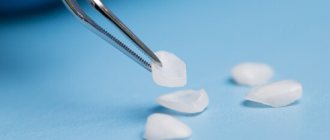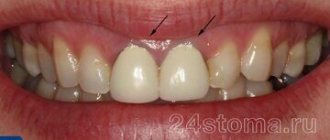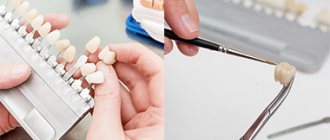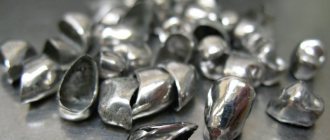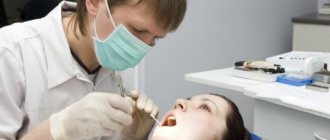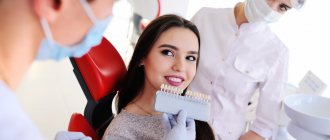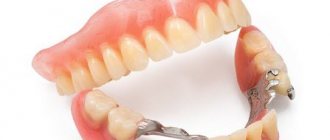Polyodontia is an abnormal number of teeth.
In medicine, this disease is often called hyperdontia, and “extra” dental elements are called supernumerary teeth. Research is still being conducted into why this pathology occurs. Most scientists associate it with disturbances in the formation of tooth germs.
Nature provides that a person grows no more than 20 milk teeth and 32 permanent teeth in a lifetime, but exceptions occur, and in our time quite often. According to statistics, on average, dental anomalies occur in 2% of the world's population, most often in men.
In 2014 alone, two operations were performed, in one of which 80 teeth were removed, and in the other, a record 232 teeth. Until this time, the maximum figure was 37 teeth.
The most common hyperdontia (anomaly in the number of teeth) is an anomaly of the upper incisors. Supernumerary teeth are less common among the lower incisors and in other parts of the jaw. They can come in a wide variety of shapes and sizes. These are usually small, cone-shaped teeth.
Extra teeth lead to deformation of the dentition, so it is recommended to remove supernumerary elements. Another reason for removal is that most patients with this pathology have a lisp.
The formation of extra teeth is quite common today. According to statistics, 70% of patients have only one extra incisor, in 25% of cases – 2 supernumerary elements, and only 5% of all patients have 3 or more teeth during examination.
Alternative options
If there is a lack of teeth in the chewing region, an alternative treatment option may be the installation of removable orthopedic structures. However, it is not always possible to fix a bridge-type prosthetic device. Sometimes the patient only has supporting units on one side of the defect, which explains the need to use a removable prosthetic system that is fixed to these teeth and gums.
Removable prosthesis. This is a fairly low-cost system that is accessible to the vast majority of patients. However, along with the effectiveness of this design, there are some negative aspects associated with its operation:
- Uncomfortable to wear. Due to the presence of a massive acrylic base, the prosthetic device can cause irritation of the gum tissue;
- Insufficiently strong fixation. Many patients resort to the use of additional gels, ointments and adhesives;
- Light load. Due to the lack of necessary pressure on the bone, it undergoes further resorption. Over time, this deteriorates the strength of the prosthetic device and leads to the need for its relocation.
Taking into account the above disadvantages, we can judge the advisability of installing dental implants instead of removable prosthetic devices using one’s own teeth as supports.
Author:
Causes of polyodontia
Medicine has not yet found an exact answer to the question of what are the causes of supernumerary teeth. Scientists put forward several hypotheses:
- Atavism. Supernumerary teeth are explained by the fact that the dental system strives to return to the original number of elements laid down by nature. There is evidence that our ancestors had 6 incisors on both the lower and upper jaws. As a result, many doctors consider atavism to be the cause of the development of polyodontia in humans.
- Splitting of the tooth germ. Even in the embryonic period, the activity of the dental plate is disrupted in the child, as a result of which hyperdontia is formed. Violations can be caused by viruses, poor ecology, drugs, medications prohibited during pregnancy, alcohol and other factors. This hypothesis is increasingly supported today, because recently the disease has been rapidly progressing due to bad habits and poor ecology.
The causes of hyperdontia continue to be researched. Scientists cannot give an exact explanation for this anomaly, but most of them are inclined to the second hypothesis - the splitting of the tooth germ at the embryonic stage.
First lower premolar
Average age of teething: 10-12 years
Average age of root formation: 12-13 years
Average length: 21.6 mm
Often considered a mystery to endodontists, the mandibular first premolar, with its two canals separating at different levels of the root, can be very difficult to machine.
The crown consists of a well-developed buccal cusp and a small or almost non-existent lingual enamel protrusion. The approach is performed buccally from the central sulcus and directed along the long axis of the root to the central cervical region. The oval-shaped pulp chamber is opened using fissure burs with a cutting apex and elongated spherical burs No. 4 or 6. In teeth with one canal, the pulp cavity in the neck area has an almost circular cross-section, and in teeth with two canals it is oval.
One study reported that “at least 23% of first mandibular premolars have a second or third canal”[17]. The canals can split almost anywhere in the root. Due to the lack of direct access, cleaning, shaping and filling these teeth can be extremely difficult.
In a recent study, Vertucci [13] showed that the first lower premolar has one canal at the apex in 74.0% of cases, two canals in 25.5% and three canals in the remaining 0.5% of cases.
Classification and frequency (%) of canal types in first and second lower premolars
By Vertucci, F. J. Am. Dent. Assoc. 97:47, 1978.
What does polyodontia look like?
Quite often, extra teeth are almost indistinguishable from normal ones. It is not uncommon for them to grow in the form of a drop or a thorn. These dental elements can appear either individually or fused with permanent ones. They can form tooth-like formations and entire arrays of teeth.
Also in medical practice, there are cases where polyodontia was hidden and was detected only by radiography. There are many different cases of abnormal development of the number of teeth, and if you notice symptoms, you should definitely contact the dentist.
Types of crowns for lower chewing teeth
Orthopedists at our centers use the following types of crowns to restore highly damaged or extracted teeth:
- Metal-ceramic crowns
are a good option for budget-friendly prosthetics of back teeth. The strength of the structure is ensured by a metal frame with multilayer ceramic cladding.
The material for making the base of the prosthesis is chosen by the patient - it can be an alloy of chromium with nickel or cobalt. More expensive metals are dental gold and platinum. But if crowns on chewing teeth are created for installation on implants, then the frame of the prosthesis is made of titanium.
- Zirconium dioxide
is an ideal material for creating a crown for the lower chewing teeth. Absolute biocompatibility and the highest structural strength (the crown can be worn for more than 20 years). The natural material fully matches the structure of a natural tooth. The only weak link is the cost of the dental crown.
E-max ceramics
– an excellent combination of strength and high aesthetic characteristics. Maximum identity of the enamel of a living tooth is ensured by the light properties of the material. The material has anti-allergenic properties. The product has very thin walls, so minimal preparation of the abutment tooth is performed.
The process of installing a crown on a tooth:
- The first visit to the dentist - a visual and hardware diagnosis of the problem area is carried out. Identification of possible contraindications. Drawing up a treatment plan with subsequent prosthetics.
- Next, the patient visits the clinic for oral treatment and professional dental hygiene.
- Upon completion of the endodontic and hygienic procedures, the doctor begins grinding and taking an impression.
- While waiting for the finished product, a temporary structure is installed.
- At a return visit to the orthopedist, the patient is fitted with a dental crown created by a technician on a chewing tooth. If necessary, it is adjusted and then the prosthesis is firmly fixed to the tooth using a dental compound.
It is important that the created prosthesis is completely adjacent to the tooth stump and does not cause even minor discomfort in the patient. Therefore, sometimes a permanent crown is secured with a temporary composition. And if, after a certain period of time, the patient is satisfied with the result, then the crown is finally attached.
Types of polyodontia disease
Polyodontia in the oral cavity manifests itself in different ways. By studying the statistics, signs and symptoms of the disease, dentists were able to classify the types of this anomaly.
Depending on the origin, the disease is divided into two types:
- False polyodontia. Provides for a baby tooth that does not fall out, regardless of the person’s age. At the same time, it fulfills its functions, does not create discomfort to the bite, and is firmly fixed in the patient’s jaw. In addition, teeth fused together and other anomalies are classified as a false type of disease.
- True polyodontia. It can be caused by genetic predisposition, as well as terogenic factors. At the same time, extra molars begin to form in the human jaw.
Anatomy of permanent teeth
Each molar consists of certain parts:
- crown. This is the part of the tooth that protrudes from the top;
- the root, it goes deep into the alveoli. At the same time, it is attached thanks to special connective tissue bundles. There can be different numbers of roots (1-5 pieces). This moment affects the number of nerves and channels;
- neck. This part is located between the root and the crown.
Tooth tissues are distinguished by their heterogeneity. The enamel is on top and is known for its durability. Once the tooth has erupted, it is covered with a transparent thin layer. This is the cuticle, which eventually changes to the pellicle. The latter is a film that is created from what saliva produces.
Beneath the enamel is dentin, the tissue of the tooth. Dentin is similar to bone when you study how it is built. However, it is more durable because there is a high level of mineralization. In the area where the root is located, the dental tissue is covered with cement. The latter is rich in mineral compounds and is also associated with periodontium. Collagen fibers are used for this.
As for the part of the tooth that is inside, this is the crown and root canal. They are filled with pulp. This is loose connective tissue; it contains nerve endings and blood vessels.
As for the placement of extra teeth, dentists distinguish the following types of disease:
- Typical hyperdontia. Applies to those patients in whom extra teeth appear only in the dentition and do not extend beyond it. Many scientists are confident that this is simply heredity, because our ancestors had a more developed dental system than modern people.
- Atypical hyperdontia. It occurs much less frequently and is characterized by the appearance of teeth outside the dentition.
In case of anomalies with baby teeth, the latter pose almost no threat. On the contrary, such a tooth can last a lifetime. But the permanent molars, over which the supernumeraries grow, should be removed, if only because it is not aesthetically pleasing.
Often, the patient grows extra fangs or incisors, or even several front teeth at once. In addition to a ruined smile, the disease can cause serious complications if the necessary measures are not taken in time.
Symptoms of the disease in children
The first supernumerary teeth in children appear before birth or in the first six months of life. The main inconvenience they cause is difficulty in feeding.
Polyodontia of primary teeth in older children occurs with symptoms similar to the eruption of regular teeth. In this case it is observed:
- temperature increase;
- swelling of the gums in the place where the tooth should erupt;
- pain;
- excessive salivation;
- swelling of the nasal mucosa;
- loose stool.
Symptoms are especially severe when extra teeth appear in the upper palate.
If hyperdontia makes itself felt in a two-year-old child, this can interfere with the formation of normal speech. In turn, due to injury to the tongue and mucous membranes, some kind of inflammation constantly appears in the oral cavity.
When supernumerary teeth appear in very noticeable places in school-age children, ridicule towards the patient may occur, which is fraught with the development of psychological problems and complexes in the future.
Where do teeth come from, or odontogenesis in vivo?
Naturally, before understanding bioengineering, you need to understand how a tooth initially develops in the human body.
The formation of teeth is a rather complex process, which is accompanied by tissue interaction and controlled by a huge number of signaling molecules (Fig. 3) [6].
Figure 3. Stages of tooth development. During tooth development, the tooth goes through the following stages: placode, bud, cap, bell, root development and eruption. Tooth formation begins in the area of the dental plate, which consists of mesenchymal cells and invaginated epithelium. At the first stage, a tooth germ is formed from the dental plate (placode stage). During the cap stage, the primary enamel node is formed, and at the bell stage, secondary enamel nodes are formed, which form the cusps of future tooth crowns. Here, the epithelial and mesenchymal cells of the tooth embryo differentiate into ameloblasts, odontoblasts and dental follicle cells. Ameloblasts and odontoblasts produce enamel and dentin, respectively. Dental follicle cells differentiate into periodontal tissue cells: periodontal ligament, cementum and alveolar bone.
[7]
The tooth develops from tissues formed by the germ layer ectoderm. By dividing and differentiating, ectoderm cells form the structures necessary for tooth development: the dental epithelium and neural crest, which later transforms into mesenchyme. Tooth formation is initiated and regulated by epithelial-mesenchymal interactions. The earliest sign of tooth development is the formation of the dental lamina, a horseshoe-shaped thickening of the epithelium along the upper and lower jaws. Further stages include placode, bud, cap, bell and root development [6], [7].
The interaction between epithelial and mesenchymal cells plays a major role in tooth development. Why, during the development of the embryo, is it the tooth that is formed, and not another organ, for example, the intestines? The thing is that the cells involved in tooth development have odontogenic competence. The genetic background of odontogenicity, that is, the ability of stem cells to differentiate directly into dental cells, is not fully understood, although more than 200 genes “involved” in tooth development have been identified. Many studies aimed at studying this phenomenon also pay a lot of attention to certain epithelial signaling centers. In total, we currently know about 4 such centers: the dental plate, placode, primary and secondary enamel nodes, the main role of which is the expression of signaling molecules that regulate tooth formation [8], [9].
Symptoms of hyperdontia in adults
Polyodontia affects permanent teeth more often than baby teeth. An adult usually develops dystopic and impacted supernumerary teeth.
Dystopic teeth are those that appear outside the dental arch. Most often they erupt on the lingual surface of the gums and in the palate. With this form of the disease, the patient typically:
- poor pronunciation of sounds;
- noticeable malocclusion;
- change in the usual arrangement of teeth: curvature of the angle at which they grow, as well as their rotation
- around its axis;
- frequent injury to the oral mucosa and, as a result, its inflammation;
- disruption of chewing processes, resulting in digestive problems.
Among other things, dystopic teeth often cause psychological problems. Due to a non-aesthetic, and sometimes completely unattractive smile, the patient becomes withdrawn and uncommunicative. Psychological problems, in turn, cause chronic diseases of the endocrine, digestive and nervous systems.
Impacted supernumerary teeth are teeth that do not erupt, but continue to remain in the bone tissue of the human jaw. Often they hardly make themselves felt until complications begin. Dentists diagnose this anomaly during a routine examination of the patient.
This abnormality in the number of teeth is accompanied by the following symptoms:
- normal teeth begin to loosen (the condition is considered pathological);
- the bone begins to protrude (if the impacted tooth is too close to the edge of the jaw);
- Aching pains appear periodically.
One of the most difficult situations is when extra teeth grow in place of impacted third molars. Wisdom teeth cannot grow and begin to negatively affect the roots of other teeth, which in turn can lead to serious complications.
What are the consequences of losing teeth in the chewing area?
Despite their reliability, molars and premolars are among the most susceptible teeth to pathogenic bacteria. This is due to their active participation in the process of chewing food products. Severe pathologies in the chewing area can provoke tooth loss. This, in turn, can cause such serious problems as deterioration of the anatomical characteristics of the face, disturbances in the functioning of the maxillofacial system, disruptions in the functioning of the gastrointestinal tract and other undesirable changes.
Currently, the most effective method of eliminating the defect is the implantation of chewing teeth. However, the procedure for reproducing molars and premolars differs in its specific features, which we will discuss later.
Consequences of polyodontia disease
Polyodontia in humans can often be the cause of retention. This is a phenomenon in which normal teeth are unable to erupt due to the interference of supernumerary teeth. The former may remain in the jaw or take an abnormal position.
In addition, even if the complete incisor grows before the supernumerary one, the latter will be able to displace it. This will lead to the person being unable to chew food normally. And if several extra incisors grow at once, they can cause the loss of permanent teeth.
What is better - implantation or prosthetics?
A removable denture and a bridge supported on adjacent teeth are financially economical options, but they have a number of disadvantages:
- the jawbone underneath continues to atrophy, which leads to subsidence of the structure;
- the main load goes on the supporting teeth as a result of which they are destroyed;
- short service life - 5-7 years (for comparison, crowns on implants last 15 years or more, and titanium roots themselves last a lifetime);
- look unnatural;
- removable dentures cause discomfort due to the presence of an artificial palate, they press and rub;
- the presence of metal in the frame can cause an allergic reaction.
Diagnostics
Examining supernumerary teeth during an x-ray is not as easy as it seems. They can be superimposed along the contour onto the permanent ones and remain invisible. In such cases, patients are recommended to undergo a computed tomography scan, which shows a more accurate picture of the disease.
If the extra dental elements have already erupted, the dentist can easily detect them. In practice, the patients themselves find the erupted supernumerary teeth and already at the initial appointment with the dentist they complain about the pathology.
Useful tips on how to preserve teeth from childhood
The most important requirements are regular hygiene and preventive examinations at the dentist.
It is very important for parents to develop the right habit in their child from childhood in order to maintain it for the rest of his life and protect his teeth from many dental problems. How to save teeth from childhood
| First visit to the dentist | The first visit to the dentist with your baby is necessary at the age of one year in order to make sure that the first teeth are growing and growing correctly. It is better to carry out medical examinations every six months, and after three years - every 3-4 months. This is explained by the fact that the tissues of baby teeth are quite soft and carious processes spread extremely quickly. |
| First visit to the orthodontist | You should visit an orthodontist for the first time at the age of 3-4 years. At this time, you can make the first attempts to correct the position of the jaws and elements of the dentition. Naturally, if there are serious congenital malocclusion pathologies, it is necessary to consult a doctor as soon as possible |
| When to start brushing your child's teeth | Hygienic procedures must be carried out from the moment the very first tooth appears. Many parents believe that cleaning can be neglected while the baby is on breast milk or until his firstborns are fully grown. But this is not so: the first teeth need especially careful hygiene - the growth and formation of a permanent bite largely depends on them. At the first stage, you can use a soft silicone cap, after 1-1.5 years - a baby brush with soft bristles, as well as a special paste selected according to age |
| Should a child get dentures? | Baby teeth not only need to be treated, but also replaced with children's dentures if they were removed too early. This will allow you to maintain the position of the others in the row and thereby form the correct permanent bite. |
| How often should you use a toothbrush? | You need to clean with a brush and paste 2 times a day: before breakfast and before bed, after all meals. In between, you need to use dental floss, irrigator and mouth rinse. |
| How often should you visit the dentist? | Adults need to visit a doctor every six months. Firstly, to examine the condition of the entire oral cavity, identifying problems at an early stage. Secondly, for comprehensive hygiene, which will better clean the enamel and gums from plaque |
Symptom relief
Most often, in adults, extra teeth erupt without any symptoms, but for children this can become a problem that needs to be addressed.
Supernumerary teeth erupt with the same symptoms as regular teeth, so the treatment for them is the same.
- To lower the temperature, it is recommended to give your baby Paracetamol or Ibuprofen. If the child is very small, these drugs can be used in the form of suspensions or rectal suppositories. In addition to lowering the temperature, these medications do an excellent job of treating pain and inflammation.
- To relieve gum pain, local anesthetics are used - ointments and gels (for example, Kalgel, Dentinox, Solokoseryl). These remedies cope well with painful sensations and slightly relieve inflammation.
- Adults and children over 2 years of age can be treated with folk remedies: propolis, honey, decoctions of calendula, chamomile and lemon balm. Some decoctions help reduce pain and relieve inflammation. Traditional methods of treatment should be used only after consultation with your doctor.
- If primary supernumerary teeth have partially erupted, stimulation of eruption is prescribed. For this purpose, vibration and electrical stimulation, as well as special massage, are used.
What are the symptoms of eruption of molars?
When teething, your baby may experience:
- swelling and redness of the gums
- increase in body temperature
- change in stool
- increased sensitivity and irritability
- painful sensations arise
The child becomes more restless and puts his fingers or nearby objects into his mouth. You can alleviate the child’s condition by letting him chew solid food (a piece of apple, carrot, crackers). You can also purchase special teethers and gels that have an analgesic and cooling effect.
Find out about the benefits of the Medissa Art clinic here>>>
Normal deletion
If the dentist decides that in a particular case, polyodontia can only be treated by removing an extra tooth, the patient should count on the following procedures:
- First of all, the patient should be sent for radiography. This is necessary in order to determine the size and number of roots, as well as the ratio of supernumerary and normal teeth.
- After collecting research, the doctor gives the patient anesthesia and removes excess teeth.
- In some cases, soft tissue sutures may be necessary after surgery.
Removal of impacted teeth
In order for the operation to be successful and polyodontia to be cured without any complications, the doctor must fully examine the patient and plan his further actions.
- To begin with, X-rays and/or computed tomography are performed to determine the exact topography of the anomaly.
- Removal is performed under local anesthesia, but there are cases when general anesthesia can be used on the patient.
- First, the mucous membrane is peeled off, then the bone tissue is opened and the root and crown parts of the tooth are removed.
- If necessary, bone defects are covered with osteoplastic material, and the mucous membrane is sutured.
After tooth extraction, the patient continues treatment at home: takes antibiotics (if prescribed by the attending physician), rinses the oral cavity with antiseptic solutions.
Until the wound heals after surgery, it is not recommended to eat too hot, hard or spicy food. You should also brush your teeth carefully, especially on the operated side.
Price
Our Center operates a case payment system, which guarantees patients no overpayments for additional services associated with implantation.
The implant installation case includes:
- cost of Nobel Biocare implants;
- doctor's work;
- consumables and superstructures;
- anesthesia;
- CT diagnostics before and after surgery;
- fixation of bone regeneration stimulators (up to 0.25 cm³) to the neck of the implant for simultaneous bone tissue growth in conditions of slight atrophy;
- antibiotics and painkillers at home;
- visits according to schedule.
The case for installing crowns and bridges includes:
- fixation of abutments;
- taking impressions;
- manufacturing, installation of crowns or bridges.
Sinus lifting and guided bone regeneration, if necessary, are paid separately.

